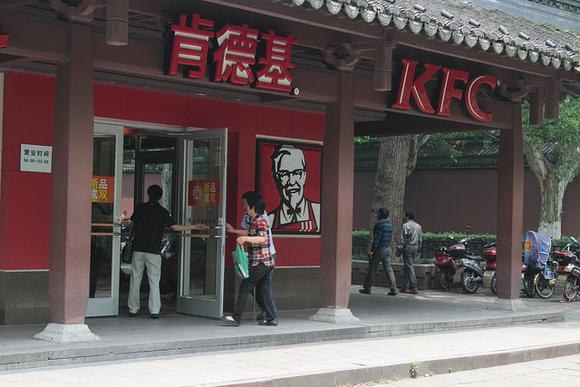
Can Yum Brands’ China division recover from back to back food safety scandals?
It’s pinning hopes on an ongoing spin-off.
Yum Brands (stylised as Yum! Brands), was a trailblazer in China’s fast food industry. It launched KFC in 1987, the first quick service restaurant to have entered the country. Three years later, the fast food operator brought Pizza Hut to China.
The success of Yum Brands China operations, particularly KFC, in the next few years was so exponential that business books and case studies rained praises on the company. By 2011, Yum Brands had a 40% hold on the country’s fast food market. The operator’s China division, Yum China, yielded about 44% of the company’s global revenue thanks largely to the stellar performance of KFC and Pizza Hut. At one point, Yum China was opening 500 new fast food outlets every year.
The tides turned, however, in 2012. Yum Brands was embroiled in a food safety scandal alongside McDonald’s Corporation. The two were accused of selling chicken products with excessive amounts of antibiotics.
Then, in late 2014, Yum Brands was again slammed with food safety issues. A TV report revealed the company’s meat supplier in China, Shanghai Husi, severely mishandling meat. Workers were seen picking up meat from a factory floor, as well as mixing meat beyond their expiration date with new meat.
The food operator immediately cut ties with its supplier, but the damage was done. Fourth quarter results of that year revealed what the Yum Brands called “slower than expected” recovery. Overall China sales tumbled 11%, and dropped 16% at stores that were operating during the scandal.
In a bid to get its operations back on track and shake off the remnants of the scandals, Yum Brands announced in October last year that it was spinning off its China operations, which contributes around 52% to revenues.
The split will result into two publicly traded companies, Yum Brands and Yum China, by end-2016. Yum China will become a franchisee of Yum Brands, and will have exclusive rights to KFC, Pizza Hut and Taco Bell brands in Mainland China.
Yum Brands sees the move as a way to maximise shareholder value, as well as to provide China operations the legroom to crawl its way out of its slump without being micromanaged from abroad.
This means, then, that Yum China will soon be able to seek exposure to China’s rapidly growing middle class without the interference of its parent company. According to a Zacks analyst report, Yum China will be able to increase its unit count by threefold over the long term. And with almost no debt in addition to substantial free cash flow, Yum China may finally solid growth.
The split appears to be paying off so far, as the China division’s comps inched up 1% YoY in December. This includes a 5% rise at KFC, but an 11% drop at Pizza Hut. In contrast, Yum China’s November same-store sales dipped 3% in November.
For the quarter, Yum Brands’ China arm inched up 2% as KFC’s 6% growth was offset by Pizza Hut’s 8% fall.
In FY15, KFC took the lead in growth, as its sales climbed 7% YoY. This was driven by 3% YoY unit growth, and accounts for 75% of revenue. Same-store sales for the year slipped 4% YoY, though.
Meanwhile, Pizza Hut in China registered lacklustre results in 2015. Sales grew 2% YoY, fueled by 1% YoY unit and same-store sales growth. Overall, Pizza Hut contributed 25% in operating profit.
For FY15, China’s division sales inched up 2% YoY, thanks to 7% YoY unit growth. Same-store sales, however, dipped 4% YoY.
According to same-store sales data from Reuters, Yum Brands still has miles to go, though. Yum Brands is still the top dog in China fast food to date, though perhaps not for long. Data suggests that Yum Brands sales in China have slowly been falling behind another Western-grown food giant—McDonald’s.
Reuters’ analysis of same-store sales growth reflect that Yum Brands’ sales in its China segment are still below 80% of the level they were in before the food safety crises. McDonald’s’ sales, on the other hand, are back above 95% of that level.
For its part, McDonald’s has been doubling down on efforts to drive sales back up to pre-scandal levels. It doesn’t hurt McDonald’s, either, that diners have been particularly sensitive about chicken products. Reuters’ same-store data suggest that its growth is organic, as opposed to being driven by new stores.
On top of this, Yum China will have to grapple with skyrocketing labour costs and rents, labour shortages, changing consumer tastes, as well as the burgeoning popularity of local rivals. In addition, the completion of the spin-off means that Yum China will be on its own legs just as China’s economy grows increasingly sluggish.
The company is obstinate to recover, though, as Yum Brands shared it expects a 10% growth in operating profits in 2016. Of this, it sees Yum China contributing 10%.
To date, Yum Brands’ China division continues to operate 7,100 restaurants under brands such as KFC, Pizza Hut, and The Little Sheep hot pot chain. Yum China states it intends to open 600 more outlets in 2016.






























